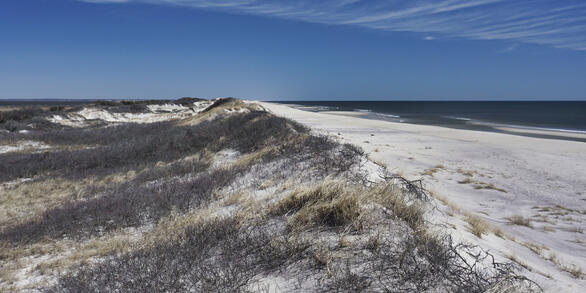Storm Impacts - Coastal System Change at Fire Island, New York
Fire Island is vulnerable to considerable storm activity year-round from both hurricanes and nor’easters. Storms are important drivers of coastal change in barrier island settings such as Fire Island. Larger storms carry sediment to the interior of the island via overwash, helping to create new habitat and build island resilience by adding back barrier width and interior elevation. Storms also cause flooding and erosion of beaches and dunes, creating hazards for ocean-front property, communities, and infrastructure. Over the last century, data collection efforts have resulted in a number of pre- and post-storm datasets that have allowed USGS researchers to quantify storm impacts from a variety of moderate to major storms.
Research
USGS measures and predicts storm-related coastal change to inform decision-makers and managers about impacts to people, infrastructure, and cultural and natural resources.


Hurricane Sandy
Resources and funding in the wake of Hurricane Sandy provided the opportunity to study the impacts of and recovery from a major storm event at Fire Island in a comprehensive way.
Other Storm Impacts to Fire Island
Since the late 1990s, USGS has been conducting research to quantify the impact from other hurricanes and nor'easters on the beaches and dunes at Fire Island.
Below are other science projects associated with this project.
Coastal System Change at Fire Island, New York
Back-barrier and Estuarine - Coastal System Change at Fire Island, New York
Oceanside Beaches and Dunes - Coastal System Change at Fire Island, New York
Open Ocean/Marine - Coastal System Change at Fire Island, New York
Nearshore - Coastal System Change at Fire Island, New York
Below are publications associated with this project.
Hurricane Sandy washover deposits on Fire Island, New York Hurricane Sandy washover deposits on Fire Island, New York
Coastal change from Hurricane Sandy and the 2012-13 winter storm season: Fire Island, New York Coastal change from Hurricane Sandy and the 2012-13 winter storm season: Fire Island, New York
Fire Island is vulnerable to considerable storm activity year-round from both hurricanes and nor’easters. Storms are important drivers of coastal change in barrier island settings such as Fire Island. Larger storms carry sediment to the interior of the island via overwash, helping to create new habitat and build island resilience by adding back barrier width and interior elevation. Storms also cause flooding and erosion of beaches and dunes, creating hazards for ocean-front property, communities, and infrastructure. Over the last century, data collection efforts have resulted in a number of pre- and post-storm datasets that have allowed USGS researchers to quantify storm impacts from a variety of moderate to major storms.
Research
USGS measures and predicts storm-related coastal change to inform decision-makers and managers about impacts to people, infrastructure, and cultural and natural resources.


Hurricane Sandy
Resources and funding in the wake of Hurricane Sandy provided the opportunity to study the impacts of and recovery from a major storm event at Fire Island in a comprehensive way.
Other Storm Impacts to Fire Island
Since the late 1990s, USGS has been conducting research to quantify the impact from other hurricanes and nor'easters on the beaches and dunes at Fire Island.
Below are other science projects associated with this project.
Coastal System Change at Fire Island, New York
Back-barrier and Estuarine - Coastal System Change at Fire Island, New York
Oceanside Beaches and Dunes - Coastal System Change at Fire Island, New York
Open Ocean/Marine - Coastal System Change at Fire Island, New York
Nearshore - Coastal System Change at Fire Island, New York
Below are publications associated with this project.








